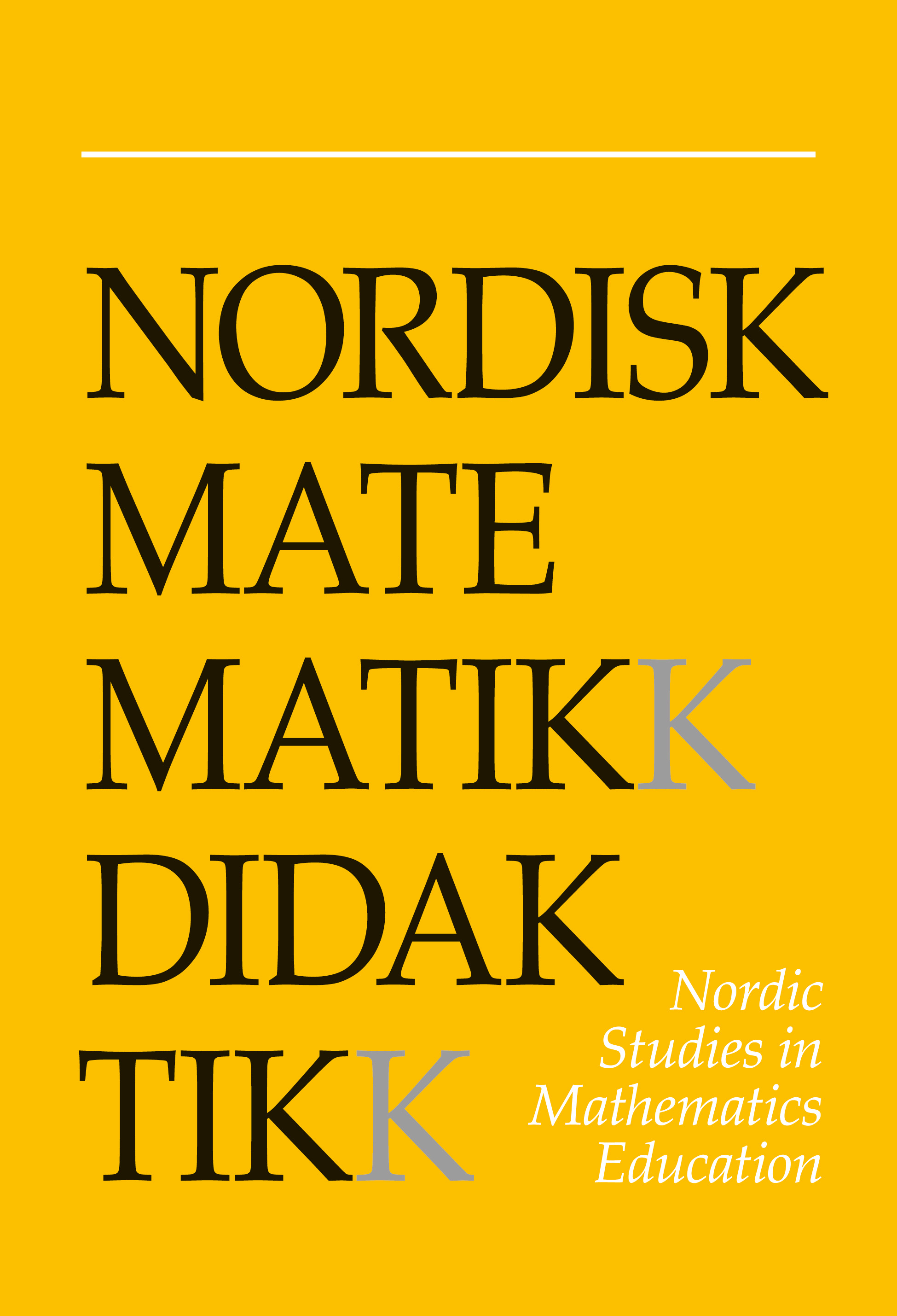Assessment of university students’ understanding of abstract binary operations
DOI:
https://doi.org/10.7146/nomad.v15i4.148287Abstract
This paper presents the results of a study on the use of interactive online tasks to assess students’ conceptual understanding of abstract binary operations in a firstyear linear algebra course. The assessment consists of recognition, identification and production tasks and uses verbal, graphic and symbolic representations of binary operations in numerous point set contexts. The aim of the study is to directly assess the students’ understanding of binary operations and – more indirectly – to identify different profiles for the students’ procedural and conceptual knowledge levels. A latent class analysis revealed different levels in students’ conceptual understanding. Implications will be drawn for teaching abstract binary operations – and other similar concepts. Finally, some suggestions about conceptual qualifications for mathematics teacher education will be discussed.
References
Asiala, M., Brown, A., DeVries, D., Dubinsky, E., Mathews, D. & Thomas, K. (1996). A framework for research and curriculum development in undergraduate mathematics education. In J. Kaput, A. H. Schoenfeld & E. Dubinsky (Eds.), Research in collegiate mathematics education II (pp. 1-32). Providence: American Mathematical Society. https://doi.org/10.1090/cbmath/006/01
Breidenbach, D., Dubinsky, E., Hawks, J. & Nichols, D. (1992). Development of the process conception of function. Educational Studies in Mathematics, 23, 247-285. https://doi.org/10.1007/BF02309532
Brown, A., DeVries, D., Dubinsky, E. & Thomas, K. (1997). Learning binary operations, groups, and subgroups. Journal of Mathematical Behavior, 16 (3), 187-239. https://doi.org/10.1016/S0732-3123(97)90028-6
Carlson, M. P. (1998). A cross-sectional investigation of the development of the function concept. In J. Kaput, A. H. Schoenfeld & E. Dubinsky (Eds.), Research in collegiate mathematics education III (pp. 114-162). Providence: American Mathematical Society. https://doi.org/10.1090/cbmath/007/04
Carlson, M. & Rasmussen, C. (Eds.) (2008). Making the connection: research and teaching in undergraduate mathematics education. Washington: Mathematical Association of America. https://doi.org/10.5948/UPO9780883859759
Davier, M. von (2000). WINMIRA 32pro. A program system for analyses with the Rasch model with the latent class analysis and with the Mixed Rasch model. Kiel: IPN.
Davier, M. von & Rost, J. (1996). Die Erfassung transsituativer Copingstile durch Stimulus-Response Inventare. Diagnostica, 42 (4), 29-48.
Ehmke, T. (2002). Geometria: a tool for the production of interactive worksheets on the web. In M. Borovcnik & H. Kautschitsch (Eds.), Technology in mathematics teaching. Proceedings of ICTMT5 in Klagenfurt 2001 (Vol. 25, pp. 137-140). Wien: öbv & hpt.
Ehmke T., Haapasalo L. & Pesonen M. (2005). Building a bridge between school and university - critical issues concerning interactive applets. In H. Ruokamo, P. Hyvönen, M. Lehtonen & S. Tella (Eds.), Teaching- studying-learning (TSL) process and mobile technologies - multi, inter-, and transdisciplinary (MIT) research approaches (Publications in Education 11) (pp. 39-47). Rovaniemi: University of Lapland.
Gray, E. & Tall, D. (1994). Duality, ambiguity and flexibility: a proceptual view of simple arithmetic. Journal for Research in Mathematics Education, 26 (2), 115-141. https://doi.org/10.2307/749505
Haapasalo, L. (1997). Planning and assessment of construction processes in collaborative learning. In S. Järvelä & E. Kunelius (Eds.), Learning & technology - dimensions to learning processes in different learning environments (pp. 51-66). University of Oulu. Retrieved August 30, 2010 from http://herkules.oulu.fi/isbn9514248104/isbn9514248104.pdf
Haapasalo, L. (2003). The conflict between conceptual and procedural knowledge: Should we need to understand in order to be able to do, or vice versa? In L. Haapasalo & K. Sormunen (Eds.), Towards meaningful mathematics and science education. Proceedings on the IXX symposium of the Finnish mathematics and science education research association (Bulletins of the Faculty of Education 86) (pp. 1-20). University of Joensuu.
Hagenaars, H. J. & McCutcheon, A. L. (Eds.) (2002). Applied latent class analysis. Cambridge: Cambridge University Press. https://doi.org/10.1017/CBO9780511499531
Hiebert, J. (Ed.) (1986). Conceptual and procedural knowledge: the case of mathematics. Hillsdale: Lawrence Erlbaum.
Humberstone, J. & Reeve, R. A. (2008). Profiles of algebraic competence. Learning and Instruction, 18 (4), 354-367. https://doi.org/10.1016/j.learninstruc.2007.07.002
Pesonen, M. (2001). WWW documents with interactive animations as learning material. Paper presented in the Joint Meeting of AMS and MAA, New Orleans, January 2001. Retrieved August 30, 2010 from http://www.joensuu. fi/mathematics/MathDistEdu/MAA2001/index.html
Pesonen, M., Haapasalo, L. & Lehtola, H. (2002). Looking at function concept through interactive animations. The Teaching of Mathematics, 5 (1), 37-45.
Pesonen, M., Ehmke, T. & Haapasalo, L. (2005). Solving mathematical problems with dynamical sketches: a study on binary operations. In E. Pehkonen (Ed.), Problem solving in mathematics education. Proceedings of the Promath meeting, June 30-July 2, in Lahti (pp. 127-140). University of Helsinki.
Pesonen, M., Haapasalo, L. & Ehmke, T. (2006). Critical look at dynamic sketches when learning mathematics. The Teaching of Mathematics, 9 (2), 19-29.
Rost, J. (1996). Lehrbuch Testtheorie Testkonstruktion. Göttingen: Huber.
Sfard, A. (1991). On the dual nature of mathematical conceptions: reflectionson processes and objects as different sides of the same coin. Educational Studies in Mathematics, 22, 1-36. https://doi.org/10.1007/BF00302715
Tall, D. (1992). The transition to advanced mathematical thinking: functions, limits, infinity and proof. In D. Grouws (Ed.), Handbook of research on mathematics teaching and learning (pp. 495-511). New York: Macmillan.
Tall, D. & Bakar, M. (1991). Students' mental prototypes for functions and graphs. Retrieved August 30, 2010 from http://www.warwick.ac.uk/staff/David.Tall/pdfs/dot1991f-mdnor-function-pme.pdf
Vinner, S. (1991). The role of definitions in teaching and learning. In D. Tall (Ed.), Advanced mathematical thinking (pp. 65-81). Dordrecht: Kluwer. https://doi.org/10.1007/0-306-47203-1_5
Vinner, S. & Dreyfus, T. (1989). Images and definitions for the concept of function. Journal for Research in Mathematics Education, 20 (4), 356-366. https://doi.org/10.2307/749441
Downloads
Published
How to Cite
Issue
Section
License

This work is licensed under a Creative Commons Attribution-NonCommercial-ShareAlike 4.0 International License.



